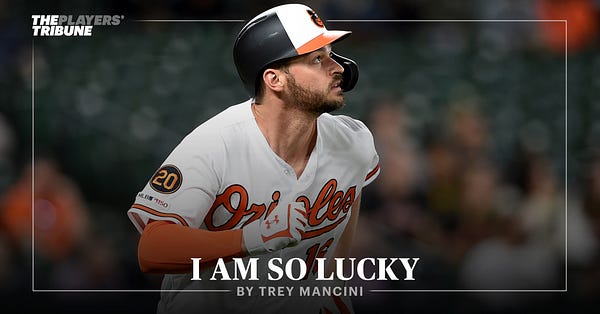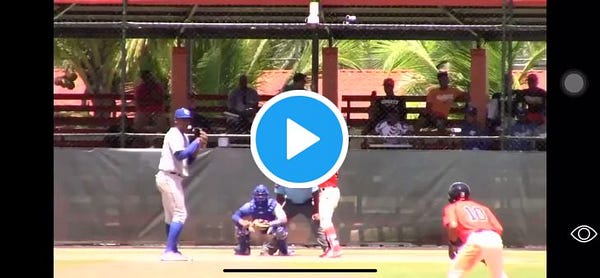I have something a little different for you today. Friday I’ll finish up my look at RHP depth in the system with a post on the relief pitchers, but today — I’m rolling out my first video chat (which was not technologically seamless!) with a special guest, Giants left-handed pitching prospect Joey Marciano.
Marciano was the Giants 36th round pick in the 2017 draft out of Southern Illinois University. His career got off to a strong start in 2018 with Augusta where he was the Sally League’s Pitcher of the Month in April and where he would later represent the Greenjackets in the Sally All Stars game.
But he hit a few bumps in his road over the next year — both on and off the field — and in 2019 he decided to retire from the game. “It’s a decision that a lot of baseball players don’t want to come to,” Marciano said, “but I had some things that were going on off the field that needed my attention, so I wasn’t really having my head on the game…it was hard for me to focus. So I needed to take some time away.”
That time off ultimately brought Joey back to the game he loves and the Giants were more than willing to have him back. (And, by the way, my apologies to longtime Good Giant farmhand Myles Schroder, whose name completely escaped me during my chat with Joey. Myles was drafted in 2007, but walked away from the game instead. It wasn’t until 2011 that he found his desire to play again and the Giants welcomed him back to the organization where he would spend the next eight professional seasons).
One thing that will be different about Marciano when he returns is his fastball. As the tweet at the top shows, Joey has picked up some velocity since he’s been gone. I asked him how he’d be working to achieve this increase. “I started doing these Run and Guns and I figured out how to get my momentum going on the Run and Guns — I was able to get up to 98 or 99 on those. And I was just thinking: ‘how can I get the same amount of force, the same amount of power…on the mound?’ I’ve been trying to create that same amount of intensity and it’s just been working for me.”
Now for those of you who aren’t up on the latest lingo — Run and Guns, in a baseball sense, are one of the signature drills run by Driveline baseball. And, as it happens, the Giants Coordinator of Pitching Sciences, Matt Daniels, (formerly of Driveline) happened to create an easy How To guide on the ideas behind Run and Guns in the following clip:
Matt also does a much better job in that video of explaining the change in pitching development philosophy that I fumblingly attempted to articulate in my chat with Joey. Though Daniels is now a major part of the Giants development braintrust, Marciano actually did most of this work himself. “They’ve taught me a lot to help finetune my game…but this is just [a matter] of finding out how my body works… and seeing if I can maximize how well I can move my body.”
But though the increase in velocity is eye-catching, Joey actually thinks the key to his development is going to be the work he’s done on his changeup. “The biggest thing moving forward…is going to be showing them that I have a feel for that changeup. That’s going to be a game-changer, especially being a lefty — having a good changeup keeps them off the fastball.”
There’s actually much more in our chat — Joey talks about how he’s trying to stay sharp during the layoff (a small, portable net in the trunk of his car has gotten a lot of use!) and also considers the benefits of being a late round draft pick — something we unfortunately may not be seeing a lot of in the future.
So please watch the whole interview above, and let us know what you think in the comments section. Would you like to see more of these kinds of video chats in the future? And if so, who would you be interested in hearing from? I’ll see what I can do! Also I will strive to ask no more “Talk about…” questions in the future!
On this day in history
Reader DOB correctly identified the 2011 San Jose Giants as Monday’s “This day in history” lineup. I really eased you into Monday morning with that one, what with the Gary Brown/Jarrett Parker duo at the top of the lineup. Parker’s 2-run homer was all the offense needed in San Jose’s 2-0 victory over Modesto on April 27, 2011.
So. Apparently I need to up the difficulty level! Guess the team and year (an old timer special!):
Garrido, SS
Alou, RF
Maldonado, CF
Hart, 3b
Davis, LF
Joseph, 1b
Talton, C
Peterson, 2b
Thomas, P
1963: 19-year-old OF Jose Cardenal, who had been spent 1962 in AAA Tacoma, hammered three home runs in his season debut for AA El Paso — suggesting he didn’t think much of the demotion. Cardenal would blast 36 homers that year in AA posting a 1.101 OPS before making his major league debut later that year. Cardenal would later be yet another victim of the Giants continual surplus of OF and would get traded to the Angels in 1965 in return for the future longtime Giants’ Farm Director Jack Hiatt.
In that same 1963 El Paso game, 21-year-old OF (yep, OF) Dick Dietz, blasted a Grand Slam continuing a hot start that saw him hit .421 over his first 10 games. Though he had primarily Caught in Fresno the year before, Dietz was being tried in the OF in deference to the superior defensive abilities behind the plate of teammate Randy Hundley. Dietz would hit .354 with 35 homers in 1963, but it would take three more years for him to climb to SF as the club worked to find a permanent defensive home for him. That 1963 El Paso club, which also included a 19-year-old Tito Fuentes had a memorable talent off the roster as well — it was managed by the legendary Giants’ scout George Genovese.
2005: Jerome Williams was pounded for six runs in 4.1 IP against Las Vegas in his first game in the minors in nearly two years. Williams had spent most of 2003 and all of 2004 in San Francisco, compiling a 4.24 ERA in the Giants’ rotation in ‘04. He struggled out of the gate in 2005, however, allowing 12 runs in 16.2 IP and was sent back to Fresno. There, things would quickly go from bad to worse. He was hammered for 24 runs in his first four starts — which totaled just 17.1 IP. After an effort on May 25 in which he allowed 7 runs, the one-time star prospect’s Giants’ career was over. He was sent to Chicago on May 28 with another former first round pick, David Aardsma, in return for LaTroy Hawkins.
A last thought
Sadly, we had some broadband connection demons while Joey was answering my question about the experience of being a 36th round pick. To complement his answer, I thought I’d leave you with Trey Mancini’s Players Tribune piece from yesterday. Mancini is going through things that are much bigger than baseball this spring, but in the course of telling his story in this excellent article he also recounts his journey to stardom, which was a long, slow trip without a lot of hype, hope, or promise at times. Just to remember that there are a many different paths to the waterfall.
I’ll be back Friday to wrap up my look at the system’s right-handed pitching by looking at the righty relief core. And then next week I’ll finally have to push on and figure out what order to put the remaining four slots: SS, LF, CF, RF. Any thoughts on what order you’d put them in?
This guy has thoughts I’ll bet:
If you liked this post from There R Giants, why not share it?










I enjoyed the interview - nice job! I’d love to see more of these. It’s nice to be able to put a face and a personality to the names we see in the boxscores throughout the season.